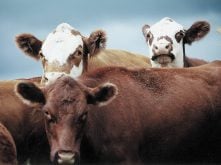This cattle market information is selected from the weekly report from Canfax, a division of the Canadian Cattlemen’s Association. More market information, analysis and statistics are available by becoming a Canfax subscriber by calling 403-275-5110 or at www.canfax.ca.
Fed cattle profitable
The Canfax weighted steer average was $150.48 per hundredweight, up $1.57, and heifers were $149.22, up 33 cents.
That was the highest price for the second half of the year and marked the eighth week of the rally.
Read Also

India slaps 30 per cent import duty on yellow peas
India has imposed a 30 per cent duty on yellow pea imports with a bill of lading date on or after Nov. 1, 2025.
Producers are now selling cattle at or above break-even levels following 16 consecutive months of losses.
One Alberta packer was offering premiums for quick delivery, while the other was buying for the beginning of January.
Both Alberta plants have been running five days a week for three weeks, but their hours might be scaled back soon to match tighter fed supplies.
Strength in Western Canada was impressive, considering that the U.S. fed market was under pressure. U.S. packers paid US$109-$112 per cwt. for cash cattle that brought $114-$115 a week earlier.
Alberta cash fed prices were at a premium to the U.S. cash market. That rarely happens in December.
Fed calves are getting cleaned up, and more yearlings are coming to market with numbers expected to remain historically tight.
Cattle-on feed placements have been below year-ago levels for six consecutive months. Third-quarter placement volumes are also the smallest since cattle-on-feed reporting began in 2000. Tighter supply should support first-quarter 2017 prices.
Cows steady
The cow market was flat following strong gains the previous two weeks.
D1, D2 cows ranged $82-$97 to average $89.93 per cwt., down 20 cents. D3 cows ranged $70-$85 to average $78.
Rail grade cows ranged $168-$173.
Slaughter bulls averaged $101.31, up $1.31.
Western Canadian cow slaughter has been 9,300-9,750 head the last five weeks, while it ranged 5,700-8,500 over the same period last year.
Feeders steady
It was the third consecutive week in which auction market volumes were substantially higher than a year ago.
Some auction marts in the central and northern Prairies saw their largest runs of the year. Heifer volumes picked up over the last couple of weeks.
The market took a breather last week after the surge in prices over the past few weeks.
Calves were mostly steady with the heavier weights under a little pressure.
However, the price slide between heavy feeders and calves is modest.
Eastern Canadian buyers were bidding, but most cattle stayed local.
The U.S. market pulled back from its recent highs, creating some market uncertainty.
Local feedlots have seen some profits as of late, and this should help support the calf market into year end.
Auction volumes are expected to seasonally decline but will likely remain above year-ago levels.
Cattle futures and the Canadian dollar will be key factors this week. The loonie rose last week.
The bred cattle market saw further price improvement.
There was strong demand for bred heifers and cows through several bred sales. They traded through the ring and electronic sales.
Bred heifer prices averaged more than $2,000 with highs to $2,600, which would account for the majority of the bred cattle.
Some lots exceed these levels.
Bred cattle are mostly returning to the breeding herd.
Beef falls
U.S. packers have given up considerable margin over the past couple of months. Margins had topped $100 per head but are now near break-even levels.
U.S. boxed beef prices have peaked and moved lower last week with Choice at US$189.48, down $1.03, and Select at $171.42, down $1.51. The demand for holiday items will likely slow down as buyers fill inventories.
Weekly Canadian cut-out values to Dec. 2 rose with AAA up C$4.95 at $253.34 and AA up 27 cents at $232.10.














